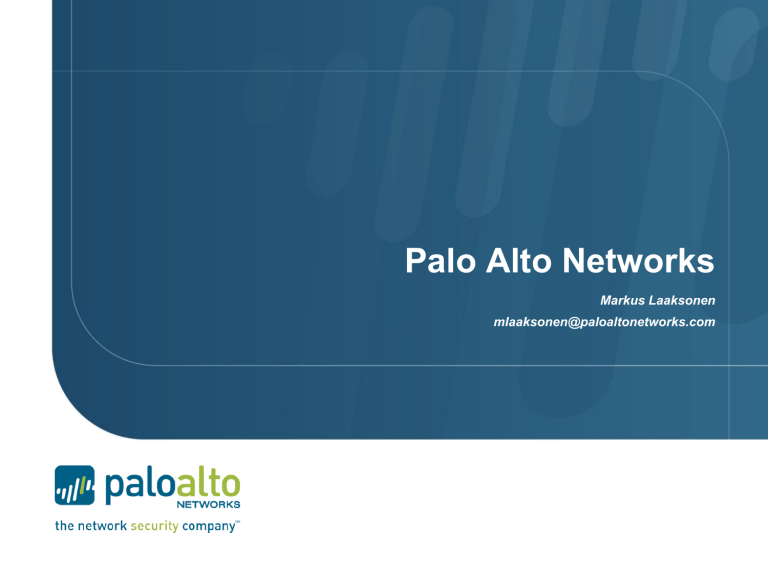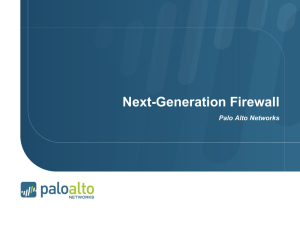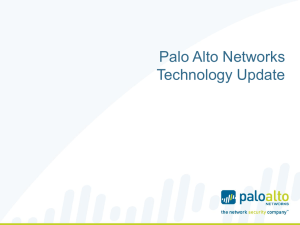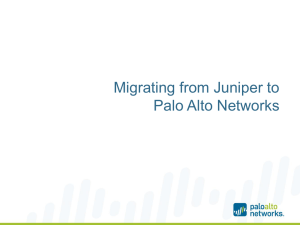Palo Alto Networks
advertisement

Palo Alto Networks Markus Laaksonen mlaaksonen@paloaltonetworks.com About Palo Alto Networks • Palo Alto Networks is the Network Security Company • World-class team with strong security and networking experience - Founded in 2005 by security visionary Nir Zuk - Top-tier investors • Builds next-generation firewalls that identify / control 1200+ applications - Restores the firewall as the core of the enterprise network security infrastructure - Innovations: App-ID™, User-ID™, Content-ID™ • Global footprint: 3,500+ customers in 50+ countries, 24/7 support Applications Have Changed; Firewalls Have Not The gateway at the trust border is the right place to enforce policy control • Sees all traffic • Defines trust boundary BUT…applications have changed • Ports ≠ Applications • IP Addresses ≠ Users • Packets ≠ Content Need to restore visibility and control in the firewall Page 3 | © 2011 Palo Alto Networks. Proprietary and Confidential. Evasive Applications Port 5050 Blocked •Port 80 •Open Page 4 | F I R E W A L L •Yahoo Messenger •PingFU - Proxy •BitTorrent Client •Port 6681 •Blocked © 2010 Palo Alto Networks. Proprietary and Confidential 3.1-a Enterprise 2.0 Applications and Risks Widespread Palo Alto Networks’ latest Application Usage & Risk Report highlights actual behavior of 1M+ users in 723 organizations - Enterprise 2.0 applications continue to rise for both personal and business use. - Tunneling and port hopping are common - Bottom line: all had firewalls, most had IPS, proxies, & URL filtering – but none of these organizations could control what applications ran on their networks 80% 60% 40% Frequency of Enterprise 2.0 Applications 100% 80% 60% 40% 20% 0% Page 5 | 96% 93% 92% 79% 85% 20% 79% 0% 47% 12% © 2011 Palo Alto Networks. Proprietary and Confidential. Top 5 Applications That Can Hop Ports 100% Sharing: Browser-based Sharing Grows File Sharing Trends Over Time • Fileshareing Trend: Frequency of use and number of applications shifts towards browser-based, coming from P2P • Use of other filesharing applications (like FTP) remains steady 100% 75% 50% 25% Mar. 2008 Oct. 2008 Mar. 2009 Browser-Based File Sharing Oct. 2009 Mar. 2010 Peer-to-peer File Sharing Oct. 2010 FTP Bandwidth Consumption Comparison • 80 filesharing applications (23 P2P, 49 BB, 9 Other Filesharing 49 TB All Other Applications 998 TB other) consuming 323 TB (24%) Browser-based Filesharing 22 TB TB – 15% of overall BW • Business benefits: easier to move large files, Xunlei (P2P) 203 TB Other P2P Filesharing 48 TB Page 6 | • Xunlei, 5th most popular P2P consumed 203 © 2011 Palo Alto Networks. Proprietary and Confidential. central source of Linux binaries • Outbound risks: Data loss is the primary business risk • Inbound risks: Mariposa is propagated across P2P (and MSN) Browser-based Filesharing: The Next P2P? • Excluding Xunlei, browser-based filesharing bandwidth is nearly 50% of P2P (22 TB vs 48 TB) • Several distinct use cases emerging - Part of infrastructure: Box.Net - Help get the job done: DocStoc, YouSendIt! - Mass sharing for dummies: MegaUpload, MediaFire, RapidShare Top 5 Browser-based Filesharing Applications Frequency They Were Found 69% Skydrive 25% Page 7 | Rapidshare 56% Rapidshare 55% 50% 19 GB Mediafire 57% MegaUpload 45 GB MegaUpload 59% DocStoc Mediafire Top 5 Browser-based Filesharing Applications - Bandwidth Consumed Per Organization 75% © 2011 Palo Alto Networks. Proprietary and Confidential. 12 GB Filer.cx 9 GB 4shared 3 GB - 25 50 Applications Carry Risk Applications can be “threats” • P2P file sharing, tunneling applications, anonymizers, media/video Applications carry threats • SANS Top 20 Threats – majority are application-level threats Applications & application-level threats result in major breaches – Pfizer, VA, US Army Page 8 | © 2011 Palo Alto Networks. Proprietary and Confidential. What the Stateful Firewall doesn’t see • Port hopping or port agnostic applications - They don’t care on what port they flow - The firewall can’t distinguish between legitimate or inappropriate use of the port/protocol - The firewall can’t control the application • Tunneled applications (= evasion) - A tunnel is built through an open port - The real application is hidden in the tunnel - It doesn’t even need to be an encrypted tunnel Page 9 | © 2011 Palo Alto Networks. Proprietary and Confidential. The Business Problem • Web 2.0 or Enterprise 2.0 applications - Use all the same port (80, 443) - Some have business value, others don’t • The Stateful firewall can’t recognize them - Page 10 | Only differentiator is the 5 tuple Source IP and port Destination IP and port Protocol © 2011 Palo Alto Networks. Proprietary and Confidential. The Business Problem • As a result, there’s no control - On the use of the application By the right user • The legitimate application function • - Only the protocol/port is seen Application control can’t be implemented based on Function • Maybe you want to allow WebEx, but not WebEx file and desktop sharing? QoS • You can’t do that on port 80 or 443 Routing • Page 11 | Only unidentified IP addresses are seen Like regular web browsing should use a cheap DSL connection © 2011 Palo Alto Networks. Proprietary and Confidential. The Firewall helpers • In order to address the shortcomings, enterprises have been adding firewall helpers in their network - IPS - Proxy with or without a Web Filter - To scan and prevent malware infections IM, QoS, … Page 12 | To control web access, but only on standard ports Network AV - To detect threats as well to block unwanted applications To address remaining issues © 2011 Palo Alto Networks. Proprietary and Confidential. Technology Sprawl & Creep Are Not The Answer Internet • “More stuff” doesn’t solve the problem • Firewall “helpers” have limited view of traffic • Complex and costly to buy and maintain • Putting all of this in the same box is just slow Page 13 | © 2011 Palo Alto Networks. Proprietary and Confidential. Traditional Multi-Pass Architectures are Slow •IPS Policy •AV Policy •URL Filtering Policy •IPS Signatures •AV Signatures •Firewall Policy •HTTP Decoder •IPS Decoder •AV Decoder & Proxy •Port/Protocol-based ID •Port/Protocol-based ID •Port/Protocol-based ID •Port/Protocol-based ID •L2/L3 Networking, HA, Config Management, Reporting •L2/L3 Networking, HA, Config Management, Reporting •L2/L3 Networking, HA, Config Management, Reporting •L2/L3 Networking, HA, Config Management, Reporting Traditional Systems Have Limited Understanding Some port-based apps caught by firewalls (if they behave!!!) Some web-based apps caught by URL filtering or proxy Some evasive apps caught by an IPS None give a comprehensive view of what is going on in the network Page 15 | © 2011 Palo Alto Networks. Proprietary and Confidential. Why It Has To Be The Firewall Firewall IPS 1. Path of least resistance - build it with legacy security boxes 2. Applications = threats 3. Can only see what you expressly look for 1. Most difficult path - can’t be built with legacy security boxes 2. Applications = applications, threats = threats 3. Can see everything Applications Firewall Applications IPS Traffic decision is made at the firewall No application knowledge = bad decision WhatYou You See See…with non-firewalls What with With A Firewall The Right Answer: Make the Firewall Do Its Job New Requirements for the Firewall 1. Identify applications regardless of port, protocol, evasive tactic or SSL 2. Identify users regardless of IP address 3. Protect in real-time against threats embedded across applications 4. Fine-grained visibility and policy control over application access / functionality 5. Multi-gigabit, in-line deployment with no performance degradation Page 18 | © 2011 Palo Alto Networks. Proprietary and Confidential. Identification Technologies Transform the Firewall •App-ID™ •Identify the application •User-ID™ •Identify the user •Content-ID™ •Scan the content Page 19 | © 2011 Palo Alto Networks. Proprietary and Confidential. App-ID: Comprehensive Application Visibility • Policy-based control more than 1200 applications distributed across five categories and 25 sub-categories • Balanced mix of business, internet and networking applications and networking protocols • 3 - 5 new applications added weekly • App override and custom HTTP applications help address internal applications App-ID is Fundamentally Different • Always on, always the first action • Sees all traffic across all ports • Built-in intelligence • Scalable and extensible Much more than just a signature…. © 2010 Palo Alto Networks. Proprietary and Confidential. •Page User-ID: Enterprise Directory Integration • Users no longer defined solely by IP address - Leverage existing Active Directory infrastructure without complex agent rollout - Identify Citrix users and tie policies to user and group, not just the IP address • Understand user application and threat behavior based on actual AD username, not just IP • Manage and enforce policy based on user and/or AD group • Investigate security incidents, generate custom reports Content-ID: Real-Time Content Scanning Detect and block a wide range of threats, limit unauthorized data transfer and control non-work related web surfing • Stream-based, not file-based, for real-time performance - Uniform signature engine scans for broad range of threats in single pass - Vulnerability exploits (IPS), viruses, and spyware (both downloads and phone-home) • Block transfer of sensitive data and file transfers by type - Looks for CC # and SSN patterns - Looks into file to determine type – not extension based • Web filtering enabled via fully integrated URL database - Local 20M URL database (76 categories) maximizes performance (1,000’s URLs/sec) - Dynamic DB adapts to local, regional, or industry focused surfing patterns How the ID Technologies Work Together Allowed for this specific user or group? (User ID) Google Talk GMail HTTP SSL Port Number What is the traffic and is it allowed? (App-ID) What risks or threats are in the traffic? (Content ID) Inbound Full cycle threat prevention • Intrusion prevention • Malware blocking • Anti-virus control • URL site blocking • Encrypted and compressed files Outbound Data leakage control • Credit card numbers • Custom data strings • Document file types Single-Pass Parallel Processing™ (SP3) Architecture Single Pass • Operations once per packet - Traffic classification (app identification) - User/group mapping - Content scanning – threats, URLs, confidential data • One policy Parallel Processing • Function-specific parallel processing hardware engines • Separate data/control planes Up to 20Gbps, Low Latency Page 25 | © 2011 Palo Alto Networks. Proprietary and Confidential. ‘Secrets’ of the real NGFW • Parallel processing versus serial processing - No dedicated engines per security feature - Consistent syntax for all threat capabilities • App and User awareness at policy decision point - Only allow those application you want to - For well known users Actively reduce the threat vector Mariposa can’t behave as a trusted application • Seen as Unkown-UDP • Would have passed the traditional firewall - Where single UDP packets, on an allowed port, will pass Page 26 | False positives are heavily reduced by tight application control © 2011 Palo Alto Networks. Proprietary and Confidential. ‘Secrets’ of the real NGFW – Cont. • Powerful Network Processors - Cabable of handling ‘traditional’ firewall features Routing, NAT, QoS, … • Enhanced hardware - Powerful and Optimized Security Processors No regular ‘data center’ processors Very high core density Very flexible • No fixed iterations like with ASICs SSL, IPSec, Decompression Acceleration • Fast, but multi-purpose Content Scanning Engines Page 27 | Supporting consistent inspection syntax © 2011 Palo Alto Networks. Proprietary and Confidential. In Other Words Next-Generation Application Control and Threat Prevention Looks Like… Full, Comprehensive Network Security Only allow the apps you need » Traffic limited to approved business use cases based on App and User » Attack surface » The ever-expanding reduced by orders of magnitude universe of applications, services and threats Page 29 | © 2011 Palo Alto Networks. Proprietary and Confidential. Clean the allowed traffic of all threats in a single pass » Complete threat library with no blind spots Bi-directional inspection Scans inside of SSL Scans inside compressed files Scans inside proxies and tunnels Firewall Remake – Real World Use • A remake, not inventing the wheel again - Page 31 | Firewall’s are intended to enforce a ‘positive’ policy Facebook & Twitter posting are allowed for marketing people Facebook reading is allowed for known users Engineers have access to source code if PC has disk encryption on Apps that can tunnel other apps are not allowed at all Web-Browsing is allowed via the DSL line (with full threat scanning) SSL decryption is required for none financial and medical sites Enterprise Web 2.0 apps can be accessed via the MPLS cloud IM and WebEx are allowed, but without file or desktop sharing Streaming media is allowed, but rate limited to 256Kbps Remote access SSL-VPN traffic must be controlled by application … © 2011 Palo Alto Networks. Proprietary and Confidential. Transforming The Perimeter and Datacenter Internet Datacenter Perimeter Enterprise Datacenter Page 32 | Same Next-Generation © 2010 Palo Alto Networks. Proprietary and Confidential. Firewall, Different Benefits… PAN-OS PAN-OS Core Firewall Features Visibility and control of applications, users and content complement core firewall features • Strong networking foundation - Dynamic routing (BGP, OSPF, RIPv2) - Tap mode – connect to SPAN port - Virtual wire (“Layer 1”) for true transparent in-line deployment - L2/L3 switching foundation - Policy-based forwarding - IPv6 support • VPN - All interfaces assigned to security zones for policy enforcement • High Availability - Active/active, active/passive - Configuration and session synchronization - Path, link, and HA monitoring PA-5050 PA-5020 PA-4060 PA-4050 • Virtual Systems - Site-to-site IPSec VPN - SSL VPN • QoS traffic shaping - Max/guaranteed and priority - By user, app, interface, zone, & more - Real-time bandwidth monitor Page 34 | • Zone-based architecture PA-5060 - Establish multiple virtual firewalls in a single device (PA-5000, PA4000, and PA-2000 Series) • Simple, flexible © 2011 Palo Alto Networks. Proprietary and Confidential. management - CLI, Web, Panorama, SNMP, Syslog PA-4020 PA-2050 PA-2020 PA-500 Site-to-Site and Remote Access VPN Site-to-site VPN connectivity Remote user connectivity • Secure connectivity - Standards-based site-to-site IPSec VPN - SSL VPN for remote access • Policy-based visibility and control over applications, users and content for all VPN traffic • Included as features in PAN-OS at no extra charge Traffic Shaping Expands Policy Control Options • Traffic shaping policies ensure business applications are not bandwidth starved - Guaranteed and maximum bandwidth settings - Flexible priority assignments, hardware accelerated queuing - Apply traffic shaping policies by application, user, source, destination, interface, IPSec VPN tunnel and more • Enables more effective deployment of appropriate application usage policies • Included as a feature in PAN-OS at no extra charge Flexible Policy Control Responses • Intuitive policy editor enables appropriate usage policies with flexible policy responses • Allow or deny individual application usage • Allow but apply IPS, scan for viruses, spyware • Control applications by category, subcategory, technology or characteristic • Apply traffic shaping (guaranteed, priority, maximum) • Decrypt and inspect SSL • Allow for certain users or groups within AD • Allow or block certain application functions • Control excessive web surfing • Allow based on schedule • Look for and alert or block file or data transfer Enterprise Device and Policy Management • Intuitive and flexible management - CLI, Web, Panorama, SNMP, Syslog - Role-based administration enables delegation of tasks to appropriate person • Panorama central management application - Shared policies enable consistent application control policies - Consolidated management, logging, and monitoring of Palo Alto Networks devices - Consistent web interface between Panorama and device UI - Network-wide ACC/monitoring views, log collection, and reporting • All interfaces work on current configuration, avoiding sync issues Palo Alto Networks Next-Gen Firewalls PA-5060 PA-5050 PA-5020 20 Gbps FW/10 Gbps threat prevention/4,000,000 sessions 4 SFP+ (10 Gig), 8 SFP (1 Gig), 12 copper gigabit 10 Gbps FW/5 Gbps threat prevention/2,000,000 sessions 4 SFP+ (10 Gig), 8 SFP (1 Gig), 12 copper gigabit 5 Gbps FW/2 Gbps threat prevention/1,000,000 sessions 8 SFP, 12 copper gigabit PA-4060 PA-4050 PA-4020 10 Gbps FW/5 Gbps threat prevention/2,000,000 sessions 4 XFP (10 Gig), 4 SFP (1 Gig) 10 Gbps FW/5 Gbps threat prevention/2,000,000 sessions 8 SFP, 16 copper gigabit 2 Gbps FW/2 Gbps threat prevention/500,000 sessions 8 SFP, 16 copper gigabit PA-2050 PA-2020 PA-500 1 Gbps FW/500 Mbps threat prevention/250,000 sessions 4 SFP, 16 copper gigabit 500 Mbps FW/200 Mbps threat prevention/125,000 sessions 2 SFP, 12 copper gigabit 250 Mbps FW/100 Mbps threat prevention/50,000 sessions 8 copper gigabit Page 39 | © 2011 Palo Alto Networks. Proprietary and Confidential Flexible Deployment Options Visibility • Application, user and content visibility without inline deployment Page 40 | Transparent In-Line • IPS with app visibility & control • Consolidation of IPS & URL filtering © 2011 Palo Alto Networks. Proprietary and Confidential. Firewall Replacement • Firewall replacement with app visibility & control • Firewall + IPS • Firewall + IPS + URL filtering Comprehensive View of Applications, Users & Content • Application Command Center (ACC) - View applications, URLs, threats, data filtering activity • Add/remove filters to achieve desired result Page 41 | © 2010 Palo Alto Networks. Proprietary and Confidential. Filter on Facebook-base Filter on Facebook-base and user cook Remove Facebook to expand view of cook Enables Visibility Into Applications, Users, and Content Management Administrators and Scopes • Administrative accounts have scopes where their rights apply - Device level accounts have rights over the entire device - VSYS level accounts have rights over a specific virtual system • Administrators can be authenticated locally or through RADIUS • Administrators actions are logged in the configuration and system logs Page 44 | © 2010 Palo Alto Networks. Proprietary and Confidential 3.1-b Role Based Administration • Built-in roles: - Superuser - Device Admin - Read-Only Device Admin - Vsys Admin - Read-Only Vsys Admin • User Defined - Based on job function - Can be vsys or device wide - Enable, Read-Only and Deny Page 45 | © 2010 Palo Alto Networks. Proprietary and Confidential 3.1-b Virtual Systems • Provides administrative management boundaries • VSYS admins can only change objects tagged with their VSYS ID Page 46 | © 2010 Palo Alto Networks. Proprietary and Confidential 3.1-b Dividing Access Control VSYS – By object RBA – By Task • Zone • Tabs and Nodes • VR / Vwire / VLAN • 3 Levels of access • Interface VSYS A VSYS B User Vwire Default VR E1/3 E1/5 E1/4 E1/6 Inbound zone Internet zone Outbound zone LAN zone Page 47 | © 2010 Palo Alto Networks. Proprietary and Confidential - No Access - Read Only - Read - Write 3.1-b Upgrade PAN-OS Import Software Page 48 | Check for New Software © 2010 Palo Alto Networks. Proprietary and Confidential 3.1-b Install Imported Software Update Applications, Threats, and Antivirus Schedule and Check for New Content Page 49 | Import Content © 2010 Palo Alto Networks. Proprietary and Confidential Install Imported Content 3.1-b Schedule URL Update Weekly Content Update Page 50 | © 2011 Palo Alto Networks. Proprietary and Confidential. Weekly Content Update Page 51 | © 2011 Palo Alto Networks. Proprietary and Confidential. Panorama 4.0 Revolution Centralized Visibility, Control and Management • Centralized policy management • Simplifying firewall deployments and updates • Centralized logging and reporting • Log Storage and High Availability No HA – Local Storage • Exactly like the 3.1 solution - 2 TB storage - 1 virtual appliance Primary Manager and Log collector No HA – NFS Storage • Extensible storage - 1 NFS Server - 1 virtual appliance - Logs stored externally Primary Manager and Log collector NFS Mount HA – Local Storage • Full redundancy - 2 TB storage - 2 virtual appliances - Devices log to both Primary and Secondary Panorama by default Primary Manager and Log collector Secondary Manager and Log collector HA – NFS Storage • Full redundancy and extended storage - 1 NFS Server - 2 virtual appliances - Devices log to Primary only - Admin may convert secondary to primary for log collection Primary Manager and Log collector Secondary Manager and Log collector Shared NFS Mount Panorama Interface • Uses similar interface to devices • “Panorama” tab provides management options for Panorama Page 58 | © 2010 Palo Alto Networks. Proprietary and Confidential 3.1-b Panorama Interface • Panorama • Device Page 59 | © 2011 Palo Alto Networks. Proprietary and Confidential. Shared Policy • Rules can be added before or after device rules • Rules can be targeted to be installed on specific devices Page 60 | © 2010 Palo Alto Networks. Proprietary and Confidential 3.1-b Panorama Full Rule Sharing Page 61 | © 2011 Palo Alto Networks. Proprietary and Confidential. Shared Policy Shared Rules • Panorama Policy rulebases are tied to Device Groups • No concept of global rules which apply to all managed devices • Pre/Post-rules cannot be edited inside firewall once pushed - This is true even when in device specific context inside Panorama Component : Shared Policy Targets • Rules can be “targeted” to individual devices Targets can be negated View and Commit View combined policy for any device Push and Commit device from Panorama managed devices view Page 64 | © 2010 Palo Alto Networks. Proprietary and Confidential 3.1-b Implementation : Comprehensive Config Audit • 4.0 allows “Comprehensive Config Audit” - Running vs. Candidate config on both Panorama and firewall Can be run on entire device group • Can help to avoid collisions or partially configured device commit - Will indicate if device candidate config exists pre-Commit All Configuration Auditing • The diff of the files is displayed • Color codes changes Page 66 | © 2010 Palo Alto Networks. Proprietary and Confidential 3.1-b Panorama Software Deployment • Managed Firewalls download content from Panorama Agents PANOS Firewall Content Firewall • Panorama downloads Software from the Internet - Content - PANOS - Agents - SSL VPN client Page 67 | Panorama © 2010 Palo Alto Networks. Proprietary and Confidential Firewall Firewall 3.1-b PA-5000 Series: Preview of the Fastest Next-Generation Firewall PA-5000 Series • A picture is worth a thousand words… RJ45 Ports SFP Ports Hot Swap Fan Tray Page 69 | SFP+ Ports Dual AC/DC Hot Swap Supplies © 2010 Palo Alto Networks. Proprietary and Confidential. Dual 2.5 SSD with Raid 1 Note: Systems ship with single,120GB SSD Introducing the PA-5000 Series • High performance Next Gen Firewall • 3 Models, up to 20Gbps throughput, 10Gbps threat PA-4020 PA-4050 PA-4060 PA-5020 PA-5050 PA-5060 Threat Gbps 2 5 5 2 5 10 Firewall Gbps 2 10 10 5 10 20 Mpps 5 5 5 13 13 13 CPS 60K 60K 60K 120K 120K 120K SSL/VPN Gbps 1 2 2 2 4 4 IPSec Tunnels 2K 4K 4K 2K 4K 8K Sessions 500K 2M 2M 1M 2M 4M Ethernet 16xRJ45 8xSFP 16xRJ45 8xSFP 12xRJ45 8xSFP 12xRJ45 8xSFP 4xSFP+ 4xXFP 4xSFP Note: Performance testing and verification are under way…. Page 70 | © 2010 Palo Alto Networks. Proprietary and Confidential. 12xRJ45 8xSFP 4xSFP+ PA-5000 Series Architecture • Highly available mgmt • High speed logging and route update • Dual hard drives RAM Quad-core CPU RAM HDD HDD Control Plane • 80 Gbps switch fabric interconnect • 20 Gbps QoS engine Switch Fabric QoS RAM Signature Match HW Engine • Stream-based uniform sig. match • Vulnerability exploits (IPS), virus, spyware, CC#, SSN, and more RAM CPU 1 CPU ... CPU 2 12 RAM CPU 1 CPU ... CPU 2 12 RAM RAM Signature Match • 40+ processors RAM • 30+ GB of RAM RAM • Separate high speed data and 10Gbps control planes RAM RAM 10Gbps CPU 1 RAM • 20 Gbps firewall throughput RAM De- threat prevention throughput De•SSL 10IPSec Gbps SSL IPSec SSL Compress. Compress. • 4 Million concurrent sessions CPU ... CPU 2 12 IPSec RAM RAM DeCompress. 20Gbps Security Processors • High density parallel processing for flexible security functionality • Hardware-acceleration for standardized complex functions (SSL, IPSec, decompression) Switch Fabric Page 71 | Signature Match RAM © 2011 Palo Alto Networks. Proprietary and Confidential. Flow control Route, ARP, MAC lookup Data Plane NAT Network Processor • 20 Gbps front-end network processing • Hardware accelerated per-packet route lookup, MAC lookup and NAT PA-5000 Series Control Plane • Significantly more powerful control plane compared to PA-4000 Series systems • Quad core Intel Xeon (2.3Ghz) + 4GB memory • Dual, externally removable, 120GB or 240GB SSD storage • Quad-core mgmt • High speed logging and route update Core 1 Core 2 RAM Core 3 Core 4 RAM Control Plane Page 72 | © 2010 Palo Alto Networks. Proprietary and Confidential. + Note: Base systems ship with a single, 120GB SSD drive. PA-5000 Series Data Plane DP0 Switch Fabric FPGA Fast Path CPU 1 SSL SFP+ x 4 Switch Fabric Flow control CPU ... CPU 2 12 IPSec RAM DeCompress. Signature Match HW Engines DP1 CPU 1 CPU ... CPU 2 12 Route, ARP, MAC lookup SSL SFP x 4 RAM IPSec RAM RAM RAM Signature Match DeCompress. DP2 NAT CPU 1 SSL PA-5060 Only © 2010 Palo Alto Networks. Proprietary and Confidential RAM RAM QoS RJ45 x 12 RAM CPU ... CPU 2 12 IPSec RAM RAM RAM DeCompress. Signature Match RAM RAM RAM PA-5000 Series Basic Packet Flow First Packet 1. Packet received 2. FPGA lookup, no match, sent to DP0 DP0 performs L2-4 session setup 3. Packet forwarded to a DP 2 DP0 CPU 1 SSL CPU ... CPU 2 12 IPSec RAM RAM Signature Match HW Engines DeCompress. 1 Switch Fabric SFP+ x 4 Flow control 3 5 CPU 1 DP1 CPU ... CPU 2 12 Route, ARP, MAC lookup 6 SSL SFP x 4 IPSec RAM RAM 4 RAM Signature Match DeCompress. DP2 NAT 4. Signature match, if necessary 5. FPGA Session Table Updated 6. Packet forwarded out of system © 2010 Palo Alto Networks. Proprietary and Confidential RAM RAM QoS RJ45 x 12 RAM CPU 1 SSL CPU ... CPU 2 12 IPSec RAM RAM RAM DeCompress. Signature Match RAM RAM RAM PA-5000 Series Basic Packet Flow 2-N Packets (requiring inspection) 1. Packet received 2. FPGA lookup, match, sent to DP1 3. Signature match, if necessary 4. Packet forwarded out of system DP0 CPU 1 SSL CPU ... CPU 2 12 IPSec RAM RAM Signature Match HW Engines DeCompress. 1 SFP+ x 4 Switch Fabric Flow control DP1 2 CPU 1 CPU ... CPU 2 12 Route, ARP, MAC lookup SFP x 4 4 SSL 3 IPSec RAM RAM RAM Signature Match DeCompress. DP2 NAT CPU 1 SSL © 2010 Palo Alto Networks. Proprietary and Confidential RAM RAM QoS RJ45 x 12 RAM CPU ... CPU 2 12 IPSec RAM RAM RAM DeCompress. Signature Match RAM RAM RAM PA-5000 Series Basic Packet Flow 2-N Packets (Fast Path) 1. Packet received FPGA lookup, match Packet processed by FPGA 2. Packet forwarded out of system DP0 CPU 1 SSL CPU ... CPU 2 12 IPSec RAM RAM DeCompress. Signature Match HW Engines 1 Switch Fabric SFP+ x 4 Flow control DP1 CPU 1 CPU ... CPU 2 12 Route, ARP, MAC lookup 2 SSL SFP x 4 IPSec RAM RAM RAM Signature Match DeCompress. DP2 NAT CPU 1 SSL © 2010 Palo Alto Networks. Proprietary and Confidential RAM RAM QoS RJ45 x 12 RAM CPU ... CPU 2 12 IPSec RAM RAM RAM DeCompress. Signature Match RAM RAM RAM PA-5000 Series Basic Packet Flow “Special Packets” DP0 1. Packet received 2. FPGA lookup, match, sent to DP0 3. Packet forwarded out of system CPU 1 2 SSL CPU ... CPU 2 12 IPSec RAM RAM DeCompress. Signature Match HW Engines 1 SFP+ x 4 Switch Fabric Flow control 3 3 CPU 1 DP1 CPU ... CPU 2 12 Route, ARP, MAC lookup SSL SFP x 4 IPSec RAM RAM RAM Signature Match DeCompress. DP2 NAT CPU 1 The following types of sessions are always installed on DP0: Tunnel sessions; Predict sessions; Host-bound sessions; Non TCP/UDP sessions; © 2010 Palo Alto Networks. Proprietary and Confidential RAM RAM QoS RJ45 x 12 RAM SSL CPU ... CPU 2 12 IPSec RAM RAM RAM DeCompress. Signature Match RAM RAM RAM Scaling Horizontally • Sometimes one PA-5060 just isn’t enough! EtherChannel Load Balancing (ECLB) Aggregate Ethernet or EtherChannel interwebs • Relatively simple and cheap • Load Share up to 8 devices • 1-arm connection to each FW • No state sync between FW’s • Use Src/Dst IP for LB hash L2/L3 Switch • Depending on the switch, not perfect traffic distribution • Consider N+1 design to cover load during maintenance Scaling Horizontally • Sometimes one PA-5060 just isn’t enough! L3/L4 Load Balancers interwebs • Can be costly and complex • More control over flows L3/L4 load balancers huge ip • Can scale >8 devices • No state sync between FW’s • Consider N+1 design to cover load during maintenance L3/L4 load balancers huge ip corp net GlobalProtect™ Securing Users and Data in an Always Connected World Introducing GlobalProtect • Users never go “off-network” regardless of location • All firewalls work together to provide “cloud” of network security • How it works: - Small agent determines network location (on or off the enterprise network) - If off-network, the agent automatically connects the laptop to the nearest firewall via SSL VPN - Agent submits host information profile (patch level, asset type, disk encryption, and more) to the gateway - Gateway enforces security policy using App-ID, User-ID, Content-ID AND host information profile Page 81 | © 2011 Palo Alto Networks. Proprietary and Confidential. A Modern Architecture for Enterprise Network Security exploits malware botnets • Establishes a logical perimeter that is not bound to physical limitations • Users receive the same depth and quality of protection both inside and out • Security work performed by purpose-built firewalls, not end-user laptops • Unified visibility, compliance and reporting Page 82 | © 2011 Palo Alto Networks. Proprietary and Confidential. GlobalProtect Topology Portal Gateway Gateway Gateway 1 4 32 Client 1. Client attempts SSL connection to Portal to retrieve latest configuration 2. Client does reverse DNS lookup per configuration to determine whether on or off network (e.g. lookup 10.10.10.10 and see if it resolves to internal.paloalto.local) 3. If external, client attempts to connect to all external gateways via SSL and then uses one with quickest response 4. SSL or IPSec tunnel is established and default routes inserted to direct all traffic through the tunnel for policy control and threat scanning 83 83 © 2011 Palo Alto Networks. Proprietary and Confidential. Gateway Global Protect Page 84 | © 2011 Palo Alto Networks. Proprietary and Confidential. Global Protect Page 85 | © 2011 Palo Alto Networks. Proprietary and Confidential. Global Protect Page 86 | © 2011 Palo Alto Networks. Proprietary and Confidential. Global Protect Page 87 | © 2011 Palo Alto Networks. Proprietary and Confidential. Global Protect Page 88 | © 2011 Palo Alto Networks. Proprietary and Confidential. Global Protect Page 89 | © 2011 Palo Alto Networks. Proprietary and Confidential. PAN-OS 4.0: A Significant Milestone PAN-OS 4.0 App-ID Custom App-IDs for unknown protocols - App and threats stats collection - SSH tunneling control (for port forwarding control) - 6,000 custom App-IDs - Threat Prevention & Data Filtering - User-ID Windows 2003 64-bit, Windows 2008 32- and 64-bit Terminal Server support; XenApp 6 support - Client certificates for captive portal - Authentication sequence flow - Strip x-forwarded-for header - Destination port in captive portal rules - Page 91 | © 2010 Palo Alto Networks. Proprietary and Confidential. Behavior-based botnet C&C detection PDF virus scanning Drive by download protection Hold-down time scan detection Time attribute for IPS and custom signatures DoS protection rulebase URL Filtering Container page filtering, logging, and reporting - Seamless URL activation - “Full” URL logging - Manual URL DB uploads (weekly) - Threat updates 4.0 Bot-net detection Page 92 | © 2010 Palo Alto Networks. Proprietary and Confidential. - Advanced heuristics to detect botnets - Collates info from Traffic, Threat, URL logs to identify potential infected hosts - Reports generated daily with suspected hosts and confidence level - Uses unknown-tcp/udp, IRC and HTTP traffic(malware, recently registered, etc to identify. PAN-OS Nice Networking Page 93 | Active/Active HA HA enhancements (link failover, next-hop gateway for HA1, more) IPv6 L2/L3 basic support DNS proxy DoS source/dest IP session limiting VSYS resource control (# rules, tunnels, more) Country-based policies Overlapping IP support (across multiple VRs) VR to VR routing Virtual System as destination of PBF rule Untagged subinterfaces TCP MSS adjustment © 2010 Palo Alto Networks. Proprietary and Confidential. NetConnect SSL-VPN Password expiration notification - Mac OS support (released w/ PANOS 3.1.4) - GlobalProtect™* Windows XP, Vista, 7 support (32and 64-bit support) - Host profiling - Single sign-on - * Requires optional GlobalProtect device license PAN-OS 4.0 New UI Architecture Streamline policy management workflow - Rule tagging, drag-n-drop, quick rule editing, object value visibility, filtering, and more - Panorama - - Extended config sharing (all rulebases, objects & profiles shared to device) Dynamic log storage via NFS Panorama HA UAR from Panorama Exportable config backups Comprehensive config audit Page 94 | © 2010 Palo Alto Networks. Proprietary and Confidential. Management - FQDN-based address objects - Configurable log storage by log type - Configurable event/log format (including CEF for ArcSight) - Configuration transactions - SNMPv3 support - Extended reporting for VSYS admins (scheduler, UAR, summary reports, email forwarding) - PCAP configuration in UI Q&A Thank you Thank You Page 97 | © 2010 Palo Alto Networks. Proprietary and Confidential.








